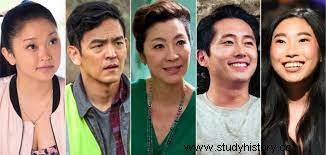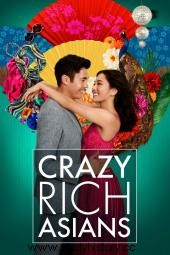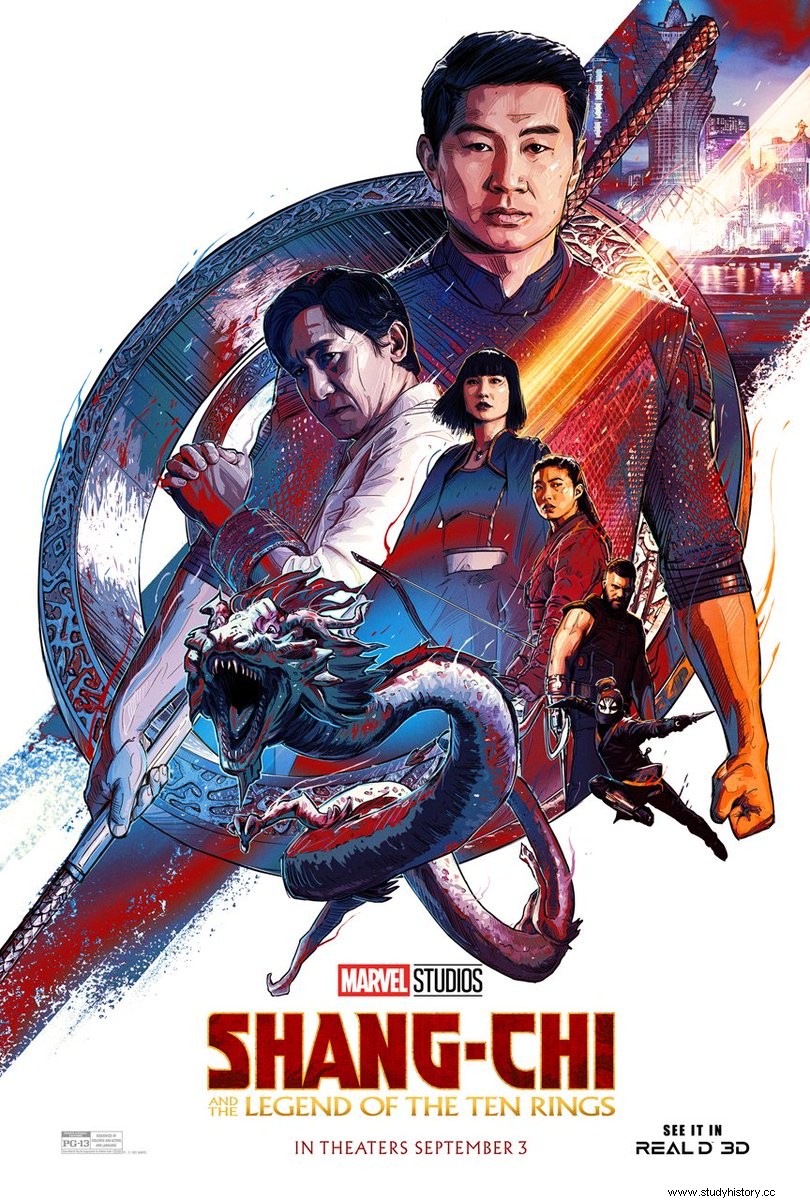Ever since the first half of the 19th century, Asian Americans have been a part of the entertainment industry. Mainly there are relatively few acting roles in TV, film and theater. Not surprisingly, many roles were available for narrow, stereotypical characters. While early Asian American actors such as Sessue Hayakawa, Anna May Wong and Bruce Lee encountered a film-making culture and industry that wanted to play them as caricatures. While some, such as actress Merle Oberon, hid their ethnicity in order to avoid discrimination against Hollywood's racist laws.
Recently, young Asian American comedians and filmmakers are finding an outlet on YouTube and the Internet, so they can have a strong, loyal and global fanbase. Major YouTubers include comedians like Ryan Higa and Kevin Wu; entertainers like Dan Chan and Christine Gambito; musicians such as MC Jin, Far East Movement, Sam Tsui, David Choi and China Grannis; and the filmmaking group Wong Fu Productions. Mainly these holders have remarkable consequences, mainly with young Asian American students, mainly through solo and collaborative videos, short films and tours.
Asian Representation in Hollywood

Image source:Coldteacollective.com
In addition, other Asian American artists have broken out into the general public outside of Asian American society. Such as Bruno Mars, Darren Criss and The Slants. The most important success in this area is the movie "Crazy Rich Asians". The film is a celebration of being a rare Hollywood studio film where all the main actors are of Asian descent. Also, adapted from Kevin Kwan's best-selling book, the sparkling romantic comedy stars Constance Wu, Henry Golding, Awkwafina and Michelle Yeoh.
While director Jon M. Chu has said that his goal is that "Crazy Rich Asians" should not just be a landmark movie, and it did much more than be a movie. It mainly started a movement for greater Asian-American representation in Hollywood. It's a daunting task, especially considering that Asian Americans (and Pacific Islanders, who are often clubbed in creating the broader "Asian Pacific American" category). Which embodies a wide range of cultural, religious, linguistic and economic backgrounds. Also, Hollywood movies have had a rocky history when it comes to their portrayals of Asian Americans. Mainly, from the early yellow face roles to the still present examples of money laundering. But there is also much to admire.
Sessue Hayakawa lager et filmstudio (1918)
Mainly, silent film actor Sessue Hayakawa was the first Asian American film star. In 1918, he had enough clout to start his own film studio, Haworth Pictures Corp. However, he began to feel frustrated by Hollywood's offensive and inaccurate portrayals of Asians. While running Haworth, 23 films under his belt as a producer and one of the highest paid actors of his time. However, he left Hollywood in 1922 due to growing anti-Asian sentiment, and eventually returned after World War II. In 1957 he received an Oscar nomination for his role in "The Bridge over the River Kwai".
Anna May Wong loses the Chinese-American role of Luise Rainer (1935)
Wong was mainly a silent film star in the 1920s, but she often found herself limited to stereotypical Asian roles. When Pearl Bucks novel "The Good Earth" (1931), Wong made the desire to be cast in the filming public because there was a rare opportunity to play a Chinese character in Hollywood. However, she later learns that she is not the right choice as the producers want a white male actor for the Chinese lead role. Furthermore, the laws against malformation prevent a non-white woman from being thrown at a white man. Instead, Wong has the role of concubine, but she refuses. Surprisingly, Luise Rainer won an Oscar for her portrayal of a Chinese woman. In addition, this was also the decade that brought us the yellowish characters Fu Manchu and Charlie Chan. The typical white characters portrayed stereotypical Asian roles as this was the product of the Western imagination.
"Flower Drum Song" is the first Hollywood movie musical with Asian Americans Leads (1961)
At the time, it was a risky choice to make a film about Asian Americans. While this was the same year as it is perfectly acceptable for Mickey Rooney to play a Japanese neighbor in "Breakfast at Tiffany's". For many years, Asian Americans still had mixed feelings about the film version of the stage musical Rodgers and Hammerstein. Mainly because it is made by non-Asians and contains Asian stereotypes, including a docile image break and a gold-digging showgirl. But in recent years, the musical (with five Oscar nominations) has been more acceptable. Mainly partly because 57 years later we have still never seen Asian Americans singing and dancing on this big stage in Hollywood.
"Enter the Dragon" makes Bruce Lee a posthumous icon (1973)
After starring as Kato in the TV series "The Green Hornet", Lee struggled to find starring roles in Hollywood. Even developing a TV project for yourself turns out to be an impossible task. Since the TV project was later reformed as "Kung Fu", starring David Carradine. This led him to go to Hong Kong, where he filmed three hit films, before getting the attention of Warner Bros., who offered him the lead role in "Enter the Dragon". Unfortunately, Lee died six days before the film's release, just as his career in the United States was about to take off. That said, not only has Lee become a global legend, he has set the stage for martial arts stars such as Jackie Chan and Jet Li.
"Gandhi" (1983) and "The Killing Fields" (1985) won big at the Oscars
Mohanda's Gandhi cinema won eight Oscars, including Best Picture and Best Actor for Ben Kingsley (who is half-British, half-Indian). Two years later, "The Killing Fields", about the escape of two journalists from Cambodia's Khmer Rouge regime, won Best Supporting Actor for Haing S. Ngor. Kingsley, Ngor and Miyoshi Umeki (who won for "Sayonara" from 1957). Furthermore, they are still the only three Asian actors who have ever won an Oscar for acting. Later, "Slumdog Millionaire" (2008) would be another British film about India that was celebrated at the Oscars.
"The Joy Luck Club" finds success as a film (1993)
Director Wayne Wang received some acclaim with 1982's "Chan Is Missing". Furthermore, this film is considered the first independent film directed by an Asian American who resonates outside Asian American society. But "The Joy Luck Club", based on the book by Amy Tan, was his first mainstream Hollywood film to become a commercial and critical success.
"The Wedding Banquet" Starts Ang Lee's Hollywood Reign (1993)
Read's comedy "The Wedding Banquet" became the most profitable film of the year. Especially when it measures the percentage of costs, and earns as much as 23.6 million dollars from a budget of 1 million dollars. He would later make history as the first non-white filmmaker to win an Oscar for Best Director, for "Brokeback Mountain" in 2005, and he would find a second for "Life of Pi" from 2012. His martial arts film "Crouching Tiger, Hidden Dragon "from 2000 is still the highest grossing foreign language film in America.
"Mulan" is the first Disney animated film starring mainly Asian characters (1998)
The Chinese legend of Hua Mulan is a story that has stood the test of time. It's about an aging warrior daughter who disguises herself as a man to take her father's place in battle. Especially for the adaptation, Disney hires a Chinese American author (Rita Hsiao) and hires mostly Asian Americans for the voices. Mainly, including Ming-Na Wen, BD Wong, James Hong, Pat Morita and George Takei. In addition, Disney would later score more hits with Asian American and Pacific Islander stories. Mainly, such as "Lilo and Stitch", "Big Hero 6" and "Moana", and a live-action adaptation of "Mulan" is underway for 2020.
"The Sixth Sense" is a cultural phenomenon (1999)
Haley Joel Osment said "I see dead people" has left an indelible mark on the memories of a generation. In particular, director M. Night Shyamalan's name is now synonymous with a certain type of supernatural horror film that ends with an astonishing twist. Although he suffers from some setbacks - especially the failure of "The Last Airbender", which he is under fire for washing the Inuit and the Asian characters in the original animated series - he has ended his successful "Unbreakable" trilogy, which will end with "Glass" in 2019.
"Harold &Kumar" is the first Hollywood series directed by Asian American actors (2004)
When "Harold &Kumar Go to White Castle", a stoner comedy starring John Cho and Kal Penn, premiered in 2004, it was not a big box office hit. But as the film came out on DVD, it gained a cult following and gave birth to two more sequels, "Harold &Kumar Escape From Guantanamo Bay" from 2008 and "A Very Harold &Kumar Christmas" from 2012. "
Justin Lin helped make the "Fast and the Furious" movies an international money maker (2009)
After Justin Lin scored an indie hit with "Better Luck Tomorrow", he directed "Fast and Furious:Tokyo Drift" from 2006. Although none of the original stars were in it, other than a quick cameo by Vin Diesel, but in Lin's next film, 2009's "Fast &Furious", Diesel, Paul Walker, Michelle Rodriguez and Jordana Brewster were back. And now the series has earned over 1.5 billion dollars. Oddly enough, Lin took a break from the franchise for a few years, but he will be back for No. 9 and 10, which are expected to be the last two parts.
Dwayne Johnson became the highest paid actress in the world (2016)
Many still know him as "The Rock", from his years as a professional wrestler, and some underestimated him when he moved to the role of "The Mummy Returns" in 2001. But 15 years later he became the highest paid actor in the world, partly through " Moana ", where he carried his Polynesian heritage proudly as the voice of the demigod Maui.
"Ghost in the Shell" whitewashed controversy (2017)
Asian American activists have been speaking out against money laundering in Hollywood for years. Mainly "Short Circuit 2", "21", "Aloha", "Dragonball:Evolution", "Dr. Rar"; the list goes on. The controversy surrounding Scarlett Johansson's cast as Major Motoko Kusanagi. The film adaptation of the Japanese manga "Ghost in the Shell", it seemed like the first time Hollywood had heard it. While Paramount CEO Kyle Davies admitted that the money laundering criticism was bad for the business.
"The Big Sick" Starred Kumail Nanjiani (2017)
Kumail Nanjiani and Emily V. Gordon wrote a screenplay based on their true romance, which eventually won an Oscar nomination for Best Original Screenplay. Surprisingly, this is the first time for a story that goes down in the Asian American experience. Despite the recognition, the film is criticized for its stereotypical portrayal of South Asian women. ("The Joy Luck Club" was also a harshly critical review of the portrayal of Asian men.) This critique highlights the impossible task of having a history that represents an entire society. And the amount of stories left to communicate on screen.
'Crazy Rich Asians' (2018) &The Farewell (2019) Break Barriers

Image source:Commonsensemedia
Before Crazy rich Asians, it had been 25 years since the world saw a predominantly Asian cast in a big budget Hollywood it was not about martial arts, nerds or a magazine with subtitles. Heller, Crazy Rich Asians is a touching, funny, beautifully shot romantic comedy that shows a modern Asian diaspora that speaks English as its main language.
While Goodbye to the Director , Lulu Wang, with the cast of the breakout star, Awkwafina, Zhao Shuzhen, Tzi Ma, Diana Lin, Lu Hong creating magic on screen. Emphasis on tears, tenderness and a largely surrealistic "true lie" encompasses Wang's strongly observed semi-autobiographical astonishment. In addition, a multigenerational, cross-cultural story about a NYC artist who visits his grandmother's last visit to China.
"Shang-Chi and the Legends of the Ten Rings" gives us the first Asian-directed superhero movie

Image source:Marvel
The brand new Marvel Phase 4 movie "Shang Chi:The Legend of the Ten Rings" broke ticket office records. At the opening three days ago at the North American box office, it raised $ 71.4 million. In addition to breaking the record for opening a weekend on Labor Day, a fantastic return at a time when cinemas are still in pandemic recovery. The film features huge powerhouse performers and behind-the-scenes talent carrying the first Asian-directed Marvel Superhero movie on his shoulders.
The film is directed by Asian-American filmmaker Destin Daniel Cretton. Shang-Chi begins many centuries ago as a Chinese warlord named Xu Wenwu (Tony Leung), aka The Mandarin, comes into possession of 10 magic rings that give him enormous power for almost a thousand years. The mystery of tradition, high action-packed sequences, friends and love are the focus of this long-awaited Marvel movie.
the conclusion
If the problematic story was not enough to open your eyes to the problem of lack of Asian representation in the media. Here are some numbers that should convince you to see the problem. According to the latest UN report, Asians represent close to 60% of the world's population, while being a separate reporter conducted by USC Annenberg in 2017 revealed that of 1,100 popular films, 70.7% of the characters were Caucasian and only 6.3% of Asian descent. Shockingly, this small number should be enough to pressure large studios and filmmakers to create more Asian-centered stories.
With this significant imbalance, the film audience has had a very limited exposure on the big screen to the diversity they are most likely to see in everyday life. In addition to alienating Asian viewers and not doing anything about preconceived, problematic notions about Asians. Mainly as the funny sidekick, the kung-fu master, the exchange student who gives the stick and all the other broad stereotypes that have played out in the film.
Beyond the predictable and limited examples of Asians depicted in regular movies. Furthermore, Hollywood also expelled Asian actors through its tendency to launder movies by casting Caucasian actors in Asian roles.
Now you know the depth of the problem, but what can we do about it? I want to know your thoughts on media representation and how you support your favorite movies and TV shows?
